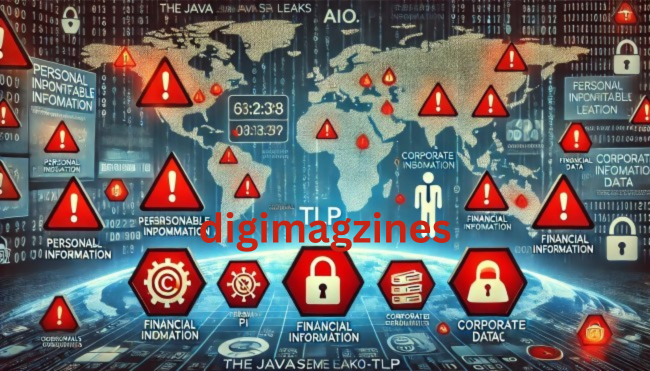The digital age has been marked by an increasing number of cyber threats and data breaches. Thejavasea.me leaks AIO-TLP stands as a stark example of the vulnerabilities present in the cyber world. This article delves into the intricacies of this particular breach, examining its scope, the data compromised, its sources, and the broader impact it has had on cybersecurity.
Overview of Thejavasea.me Leaks AIO-TLP
Thejavasea.me leaks AIO-TLP refers to a significant exposure of sensitive data through Thejavasea.me, a platform previously unknown to many until this incident. The breach involved a vast array of personal and corporate data, which was inadvertently made accessible via an “All-In-One Traffic Light Protocol” (AIO-TLP). This protocol was designed to streamline the communication and categorization of sensitive information across different sectors but was exploited due to inherent security flaws.
What is AIO-TLP?
The All-In-One Traffic Light Protocol (AIO-TLP) is a framework used to facilitate the sharing of sensitive information while restricting access to parties based on the color-coded classification of data. This system includes four colors: red, amber, green, and white, each indicating the level of sensitivity and the corresponding sharing restrictions. Unfortunately, the breach exposed how this protocol could be subverted, leading to unauthorized data access.
Scope of Thejavasea.Me Leaks AIO-TLP
The scope of this breach is extensive, impacting a wide range of entities, from individuals to large corporations. The leaked data encompassed personal identifiable information (PII), financial records, corporate strategies, and even security protocols, which were all meant to be protected under the AIO-TLP guidelines.
Types of Data Compromised
The types of data compromised in the leak were diverse:
User Credentials: This includes usernames, passwords, and security questions. These credentials could potentially allow unauthorized access to personal and business accounts.
Financial Information: Details such as credit card numbers, bank account information, and transaction histories were exposed, posing a significant risk of financial fraud.
Personal Identification Information: This includes names, addresses, phone numbers, and possibly national identification numbers, which could be used for identity theft.
Email Communications and History: Leaked emails could contain sensitive personal and business information, leading to privacy violations and potential blackmail.
Proprietary Business Information: Specific to corporate users, this includes trade secrets, business plans, and other confidential documents that could undermine business operations if accessed by competitors.
Security Configuration Details: Information about the network and security infrastructure, such as firewall settings, could enable further attacks or unauthorized system access.
Web Browsing History: This data could reveal personal interests, behaviors, and patterns that could be used for targeted advertising or more malicious purposes like social engineering attacks.
Geolocation Data: Continuous location tracking information could be used to physically track individuals, posing severe safety risks.
Sources of the Leak
Investigations into the leak have suggested multiple potential sources, including insufficient security practices at Thejavasea.me, exploitation by cybercriminals, and possibly an inside job. The exact source remains under investigation, but it highlights the need for stringent security measures.
Impact on Affected Parties
The impact of this breach has been profound. Individuals have faced identity theft, financial loss, and privacy invasions, while corporations have dealt with competitive disadvantages, financial ramifications, and reputational damage.
The Wider Cybersecurity Landscape
This incident casts a long shadow over the existing cybersecurity measures and prompts a reevaluation of data protection protocols across industries. It serves as a reminder of the persistent threats and the need for continuous improvements in cybersecurity strategies.
Challenges Highlighted by Thejavasea.Me Leaks AIO-TLP
The breach highlighted several challenges:
- Compliance and Enforcement: Ensuring adherence to established security protocols.
- Technical Deficiencies: Addressing the vulnerabilities in software and hardware used to manage sensitive data.
- Awareness and Training: Increasing the level of cybersecurity knowledge among stakeholders.
Preventative Measures and Response Strategies
In response to the breach, several measures have been suggested:
- Enhanced Security Protocols: Implementing more robust security measures and regular audits.
- Education and Instruction: Giving comprehensive education on cybersecurity most readily useful practices.
- Rapid Response Teams: Establishing specialized teams to respond to data breaches promptly.
Legal and Ethical Considerations
Legal Ramifications
The breach has potentially exposed Thejavasea.me to legal actions from affected parties, including penalties for failing to protect sensitive data.
Ethical Responsibilities
There is a moral obligation for companies to protect user data. This incident has forced a reconsideration of ethical practices in managing and protecting personal and corporate information.
Conclusion
The Thejavasea.me leaks AIO-TLP incident is a pivotal moment in cybersecurity, underscoring the need for vigilance, enhanced security practices, and a proactive stance on data protection. As digital threats evolve, so too must our strategies to counter them, ensuring the safety of data in an increasingly interconnected world.


